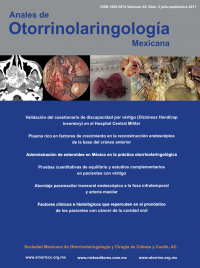An Orl Mex. 2017 jul;62(3):197-20
Gallegos-Hernández JF
Departamento de Tumores de Cabeza y Cuello, Hospital de Oncología, Centro Médico Nacional Siglo XXI, IMSS, Ciudad de México.
Resumen
El tumor maligno más frecuente de la cavidad oral es el carcinoma epidermoide, el sitio anatómico más afectado es la lengua. El cáncer oral ocupa el sexto lugar de todas las neoplasias, su prevalencia se ha incrementado en el mundo y la distribución epidemiológica tiende al cambio (con incremento importante en mujeres menores de 40 años de edad). Los factores de riesgo son el consumo de tabaco, de alcohol y la asociación de ambos, recientemente el virus del papiloma humano se relacionó como agente etiológico y como marcador de pronóstico. La supervivencia depende de factores de pronóstico, variables que inciden en la evolución que son determinantes del tipo de tratamiento a seguir, éstos pueden ser del propio paciente o del tumor. No existe un solo factor determinante, la conjunción de varios permite identificar el riesgo de muerte por la neoplasia. Los factores relacionados con el paciente son: edad, estado socio-económico, sitio de origen del tumor, la cantidad de tabaco y alcohol consumido y el género. Los asociados con el tumor son: etapa (TNM), espesor tumoral, oncotipo (variedad histológica), márgenes de resección, características ultra-estructurales y moleculares de la neoplasia (mutación p53, expresión de EGFR y la infección del virus del papiloma humano). El pilar fundamental del tratamiento es la cirugía, que permite identificar tres grupos de riesgo; intermedio, alto y muy alto; de ello depende la terapia coadyuvante a seguir.
PALABRAS CLAVE: neoplasia, cáncer oral, epidermoide, factor pronóstico, cavidad oral.
Clinical and histological factors impacting on prognosis of patients with oral cavity cancer.
An Orl Mex. 2017 July;62(3):197-208.
Gallegos-Hernández JF
Departamento de Tumores de Cabeza y Cuello, Hospital de Oncología, Centro Médico Nacional Siglo XXI, IMSS, Ciudad de México.
Abstract
Epidermoid carcinoma is the most common within the oral cavity, the tongue is the anatomical site usually affected. Nowadays, epidermoid carcinoma has the sixth place of all neoplasias, its prevalence has increased worldwide and its epidemiologic distribution shows a changeable trend (important increase in women younger than 40 years old). Risk factors are tobacco and alcohol consumption and the association between them; human papilloma virus has also been recently related with this neoplasia as an ethiological agent and prognostic marker. Survival depends on prognostic factors; i.e. variables that affect patient’s evolution and which determine the kind of treatment to be followed. They could be from the patient itself or from the tumor. There is not a single determinant factor but all of them together define a patient’s risk of death due to this neoplasia. Patients-related factors are: age, socio-economic status, tumor original site, quantity of tobacco and alcohol consumption as well as after treatment addiction, and gender. Tumor-associated factors are: stage (TNM), tumor width, oncotype (epidermoid carcinoma histological variety), surgical resection margins, ultrastructural and molecular features of neoplasia (p53 mutation, epidermal growth factor expression and papilloma virus infection). Thus, surgery becomes an essential element that determines adjuvant therapy to be followed, with three risk groups: intermediate, high and very high.
KEYWORDS: neoplasia; oral cancer; epidermoid; prognostic factor; oral cavity
Correspondencia/correspondence
Dr. José Francisco Gallegos Hernández


